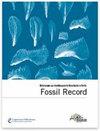下载PDF
{"title":"最大的Apateon标本及古生代鳃龙科幼崽的生活史路径","authors":"Nadia B. Fröbisch, Rainer R. Schoch","doi":"10.1002/mmng.200800012","DOIUrl":null,"url":null,"abstract":"<p>Two distinct developmental trajectories, metamorphosis and neoteny (the retention of larval somatic features in adult animals), have been reported for the small gill-bearing branchiosaurids of the Late Carboniferous and Early Permian of central Europe. Based on a very large specimen of the species <i>Apateon caducus</i> (Ammon, 1889), anatomical features characteristic for the neotenic phenotype of branchiosaurids are described. Large neotenes lack changes that occur during a short phase of transformation into terrestrial adults (metamorphosis), such as ossification of the braincase and palatoquadrate and intercentra, further ossification of the girdles and formation of muscle attachment scars and processes on the limb bones. They also lack a distinct sculpturing of the dermal skull roofing elements with deep polygonal ridges and grooves. Instead, larval somatic features are retained including ossified branchial denticles indicative of open gill slits and accentuated larval-type sculpturing of the dermal skull roof. Large size, high degree of ossification as compared to the larvae, and the presence of uncinate processes on the ribs clearly demonstrate an adult ontogenetic stage. Neotenes remained in the aquatic environment throughout their life and were most likely not capable of effective terrestrial locomotion. The frequency distribution of the two phenotypes in modern salamander populations and the environmental cues that influence the development of them provide a comparative framework for the discussion of the evolution of the two life history pathways in branchiosaurids. (© 2009 WILEY-VCH Verlag GmbH & Co. KGaA, Weinheim)</p>","PeriodicalId":55147,"journal":{"name":"Fossil Record","volume":"12 1","pages":"83-90"},"PeriodicalIF":1.4000,"publicationDate":"2009-02-20","publicationTypes":"Journal Article","fieldsOfStudy":null,"isOpenAccess":false,"openAccessPdf":"https://sci-hub-pdf.com/10.1002/mmng.200800012","citationCount":"29","resultStr":"{\"title\":\"The largest specimen of Apateon and the life history pathway of neoteny in the Paleozoic temnospondyl family Branchiosauridae\",\"authors\":\"Nadia B. Fröbisch, Rainer R. Schoch\",\"doi\":\"10.1002/mmng.200800012\",\"DOIUrl\":null,\"url\":null,\"abstract\":\"<p>Two distinct developmental trajectories, metamorphosis and neoteny (the retention of larval somatic features in adult animals), have been reported for the small gill-bearing branchiosaurids of the Late Carboniferous and Early Permian of central Europe. Based on a very large specimen of the species <i>Apateon caducus</i> (Ammon, 1889), anatomical features characteristic for the neotenic phenotype of branchiosaurids are described. Large neotenes lack changes that occur during a short phase of transformation into terrestrial adults (metamorphosis), such as ossification of the braincase and palatoquadrate and intercentra, further ossification of the girdles and formation of muscle attachment scars and processes on the limb bones. They also lack a distinct sculpturing of the dermal skull roofing elements with deep polygonal ridges and grooves. Instead, larval somatic features are retained including ossified branchial denticles indicative of open gill slits and accentuated larval-type sculpturing of the dermal skull roof. Large size, high degree of ossification as compared to the larvae, and the presence of uncinate processes on the ribs clearly demonstrate an adult ontogenetic stage. Neotenes remained in the aquatic environment throughout their life and were most likely not capable of effective terrestrial locomotion. The frequency distribution of the two phenotypes in modern salamander populations and the environmental cues that influence the development of them provide a comparative framework for the discussion of the evolution of the two life history pathways in branchiosaurids. (© 2009 WILEY-VCH Verlag GmbH & Co. KGaA, Weinheim)</p>\",\"PeriodicalId\":55147,\"journal\":{\"name\":\"Fossil Record\",\"volume\":\"12 1\",\"pages\":\"83-90\"},\"PeriodicalIF\":1.4000,\"publicationDate\":\"2009-02-20\",\"publicationTypes\":\"Journal Article\",\"fieldsOfStudy\":null,\"isOpenAccess\":false,\"openAccessPdf\":\"https://sci-hub-pdf.com/10.1002/mmng.200800012\",\"citationCount\":\"29\",\"resultStr\":null,\"platform\":\"Semanticscholar\",\"paperid\":null,\"PeriodicalName\":\"Fossil Record\",\"FirstCategoryId\":\"89\",\"ListUrlMain\":\"https://onlinelibrary.wiley.com/doi/10.1002/mmng.200800012\",\"RegionNum\":4,\"RegionCategory\":\"地球科学\",\"ArticlePicture\":[],\"TitleCN\":null,\"AbstractTextCN\":null,\"PMCID\":null,\"EPubDate\":\"\",\"PubModel\":\"\",\"JCR\":\"Q3\",\"JCRName\":\"Earth and Planetary Sciences\",\"Score\":null,\"Total\":0}","platform":"Semanticscholar","paperid":null,"PeriodicalName":"Fossil Record","FirstCategoryId":"89","ListUrlMain":"https://onlinelibrary.wiley.com/doi/10.1002/mmng.200800012","RegionNum":4,"RegionCategory":"地球科学","ArticlePicture":[],"TitleCN":null,"AbstractTextCN":null,"PMCID":null,"EPubDate":"","PubModel":"","JCR":"Q3","JCRName":"Earth and Planetary Sciences","Score":null,"Total":0}
引用次数: 29
引用
批量引用


